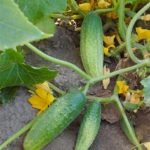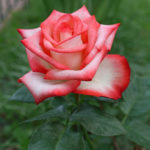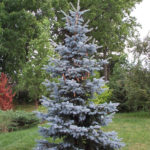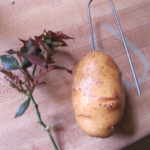Peony White cap (White cap)
Many people know that there are two-tone roses. However, there are also similar specimens among peonies. The clearest example is the White cap variety. Its incredibly beautiful inflorescences are associated with sparkling stars, and its compact shape makes it easy to find a place for an ornamental flowering shrub in the garden.
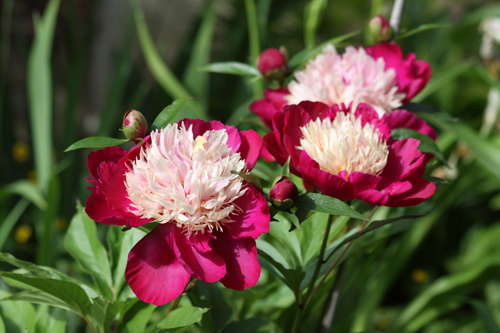
History of creation
The white cap was introduced in the middle of the last century, namely in 1956. Its author was the American breeder Winchell George E. Accordingly, the place of origin of the culture is the USA. The name of the flower in translation from English means "white cap". It is due to the fact that the inflorescences of the plant by the end of the flowering phase, under the influence of the rays of the summer sun, fade and become completely snow-white. In 1991, the culture was awarded the honorary award of the American Peony Society - a gold medal.
Description of appearance and features
Overseas perennial belongs to the Japanese group and the class of milk-flowered peonies. He is the owner of a special inflorescence, closer to the anemone, shape and striking color. Just imagine magnificent flowers with a cap of white, yellowish or creamy pinkish staminodes in the center, framed by rich dark carmine or dense crimson rounded, even petals. An amazing contrast, isn't it? Moreover, the flowers of this variety are impressive in size: they reach 20, or even 25 cm in diameter. They are so heavy in the phase of complete dissolution that they can provoke a loss of shape by the bush and even damage to the stems, which, by the way, are considered strong enough. The flowering of the culture is long and abundant. The aroma emanating from the White Cap inflorescences is pleasant, sensual, but weak. Straight shoots of an ornamental perennial are covered with bright green, pointed leaves of medium size, with a glossy sheen. The bush itself is powerful, vigorous, but not too tall - from 80 to 100 cm, no more.
Given the severity of the flowers, our hero, in the midst of the flowering period, requires tying up and establishing a support near him. The culture can boast of excellent winter hardiness: the plant easily tolerates temperatures as low as -40 ° C. It should be added that the herbaceous perennial rarely gets sick and is attacked by pests. Light intermittent rain does not harm the attractive peony flowers.
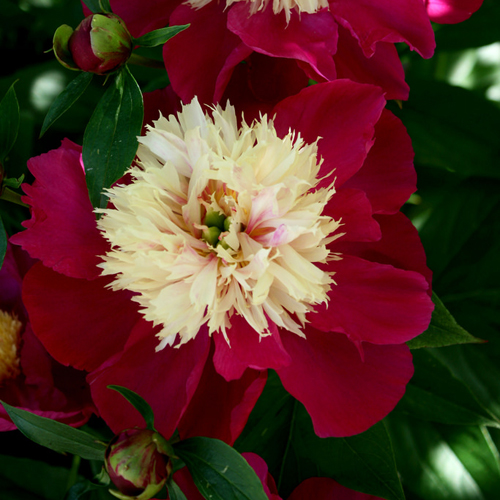
Growing and care
Since the bright silky petals of the lovely White cap inflorescences fade in the sun, it is preferable to place the crop in partial shade. If this is not possible, shade the plant yourself with a white cotton cloth at midday on summer days. Planting a crop in the shade is a radical measure that will do more harm than good: you simply will not wait for the flowering of the American handsome, or it will turn out to be inferior and very scarce. Protect the plant from drafts: strong and especially gusty winds can break flowering shrubs.
The soil in which you plan to plant the crop should be well-drained, highly fertile, fresh, moderately moist and light. Before using it for its intended purpose, dig a hole, lay a layer of fine gravel on the bottom of the hole, put some garden soil on top and apply phosphorus-potassium fertilizers. The best time to plant a peony is autumn (from late August to late September) and the second half of spring.
The white cap loves water, so it needs to be watered abundantly. The next moistening of the soil under the bush is carried out as soon as the top layer of the soil dries up. At a time, under the plant, you need to pour about two buckets of clean, soft, lukewarm water.However, keep in mind: the culture does not welcome stagnant moisture in the soil. For this reason, it should not be planted in a place where groundwater is too close to the surface of the earth.
Decorative flowering perennial needs periodic feeding. In the spring, nitrogen fertilizers are applied to the soil under the bush, so that the crop can quickly grow green mass. In the summer, when the plant is tied up, and after that the buds will open, the shrub will need mineral complexes containing potassium, phosphorus and trace elements. Two weeks after the peony has faded, the mineral dressing is repeated. It is important to remove dried leaves from the bush throughout the season. The same applies to faded inflorescences. In the fall, a perennial is pruned: all its shoots are greatly shortened, leaving a low stump. From above it is covered with mulch. A special shelter to protect the plant from frost is used only in regions with a harsh climate.
Use cases
You can make a white cap the main decoration of your garden. To do this, plant it on the lawn or in the foreground of the site. Flowering bushes of this plant along the fence, near the gazebo, on the sides of garden paths as part of the borders will be appropriate. A culture with bright flowers of Japanese shape is suitable for decorating ridges, mixborders and classic round flower beds. She will give a special charm and originality to the rock garden, rockery. In mixed compositions, phlox, irises, clematis, peonies of other varieties with flowers of raspberry, scarlet, pink, white and cream shades will become good neighbors for White cap.
